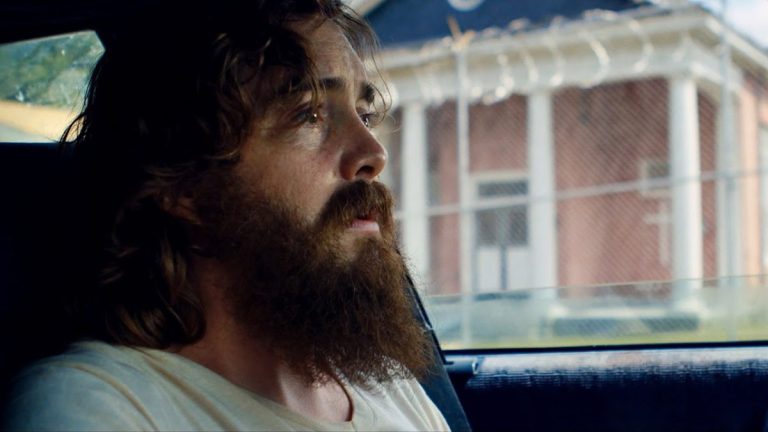Manhunt Episodes 1, 2, & 3: For most people familiar with President Abraham Lincoln’s story, his death due to assassination registers as barely a footnote. Even as history remembers Lincoln as the man responsible for effectively bringing the Civil War to an end, it stands to reason that his death at the hands of John Wilkes Booth is more the subject of conspiracy theories. At least it had been to me.
In Monica Beletsky’s adaptation of James L. Swanson’s book of the same name, the depiction of the search for Lincoln’s killer is less a proclamation of revealing unknown pieces of information and more like a deep dive into the events before and after the moments of the assassination, and of course, through the process of storytelling, tries to delve into how this event resonates within the current climate. The murder of a president is the toppling of a symbol caused by a man following a radically different ideology. It bears interest in exploring Booth’s connections to the Confederacy, and perhaps the show will choose to tackle exactly that.
Manhunt Episode 1 “Pilot” Recap:
Who are the key players in this story?
In choosing to move forward with this exploration, “Manhunt” uses two characters. The first is, of course, John Wilkes Booth (Anthony Boyle), who is first introduced with a JMB tattoo on his hand, a braggadocio with legitimate arrogance, perhaps because of his fame as a theatre star. That egotism, though, doesn’t translate to him as a lone gunman, as we see him announcing to his crew that the plan is a go.
He hands a gun to David Herold (Will Harrison), and as he walks down, we see a wordless introduction of the rest of the crew, about whom we would be given more details in the subsequent episodes: Mary Surratt and Lewis Powell. Now Powell has the mission to attack the Secretary of State. As the timeline jumps 30 minutes forward, we see Herold and Powell visit the house of William H. Seward. Herold hands Powell the gun, who brazenly knocks on the door and pretends to deliver medicine before attacking the doorman and then entering the house to presumably wound Seward to near death before walking out bloodied.
The consequence of this event leads to the introduction of the second key player, Edwin Stanton (Tobias Menzies), the Secretary of War and Lincoln’s right-hand man. We see him visiting Seward’s house at the scene of the crime and the very injured but still alive Secretary of State. The violent crime signifies the true nature of the story “Manhunt” sets out to tell: the murder of President Abraham Lincoln was part of a larger conspiracy to overturn the current government of the Union, with a three-pronged attack on the president, the vice president, and the secretary of state. As history would inform, only one had been successful.
We do meet the president (Hamish Linklater) in a time jump five days before the murder, where Lincoln regales his campaign office with the story of a young girl to underscore why the war is soon to end. His prediction comes true, as a tearful Lincoln later informs Stanton that Lee has surrendered. Stanton celebrates before doubling down with an asthma attack. As Stanton brings the news to Seward and they share a laugh regarding the circumstances of Lee’s surrender, Seward presents a sobering reminder: the war might be over, but people on the losing side still harbor grievances.
One could surmise that this is John Wilkes Booth’s mindset. It could be easily inferred that Booth hadn’t shared a drink with the security guard, Parker. But that’s an artistic license that could be attributed to plot progression, helping Booth learn that the security guard had left him unattended once the play had started. Considering Booth, who had learned that the president would be watching “Our American Cousin” later that day, this might have felt like the most poetic option for him to undertake. Ironically, Lincoln had been warned by Stanton not to attend the play because of the significant increase in death threats.
How does Lincoln die?
“Manhunt” crafts the actual event with no amount of immediacy. Watching Lincoln and his wife Mary from behind the curtain, he wastes no time in shooting Lincoln in the head as the audience is busy applauding. As the gunshot roars, Booth jumps from the balcony to the stage, raises his hand, shouts “sic semper tyrannis,” and then limps outside quickly, where Ned Spangler had kept the back door open for Booth. Joseph “Peanuts” Burroughs, who had held onto Booth’s horse, is hit by Booth as the audience finally realizes and screams that the president has been shot.
Edwin Stanton arrives at Pearson House. On his way inside, he is informed that Booth is the shooter. Inside, Mary, delirious, berates the missing security guard for leaving the president unprotected, while Robert Todd (Lincoln’s son) remarks to Stanton that he should have convinced the president not to attend. Stanton convinces Robert to take Mary home while he enters the room where Lincoln is treated.
However, upon entering, Stanton realizes that Lincoln is too far gone. Blood is billowing from the gunshot wound on his neck, and the pillow is getting soaked with blood. Stanton doesn’t have the luxury to break down, as he is informed by Chief Thomas Eckert that they have arrested the man meant to kill Vice President Johnson, but he has lost his nerve. Stanton orders DC to be closed down, wondering whether the Confederacy had a hand in the murder. Early the next morning, at 7:22 AM, Lincoln dies. Through tears, Stanton proclaims, “Now he belongs to the ages.” (it is debatable whether he meant ages or angels, but it works either way.) Lincoln is carried in a casket as a massive group of people congregates in front of Pearson House to honor him.
Where does Booth escape to?
Booth manages to cross the bridge into Anacostia because the head of security is a fan of Booth (more specifically, his wife is). But as he crosses over and meets up with Herold, he realizes he needs medical attention for his foot as well as a haven until he recuperates. Booth eventually finds safety at the home of physician Samuel Mudd (Matt Walsh), which is 30 miles outside of Washington, DC. Mudd repairs his fractured fibula but warns him that he must avoid using it for two months.
They discover Lincoln’s death in a newspaper that Herold brings in. Booth enjoys being referred to as a “symbol of the Confederate cause.” They are also waited on by Mary Simms, a servant enslaved in Mudd’s employ and treated akin to one previously before the war. Mary becomes the object of Booth as well as Harold’s racist insults and lascivious stares, which just proves how much the end of the war hasn’t affected them as of yet.
What does Stanton find in Booth’s room?
Stanton, meanwhile, resumes the investigation immediately. He is questioned by Sanford Conover of the New York Tribune about whether Lincoln’s death would divide the country yet again and whether Stanton’s loyalties lie with African Americans rather than his fellow men. Stanton invites the journalist to Pearson House and instructs him to photograph the bed where Lincoln died “like a battlefield.” The tense interview ends with Stanton’s clipped proclamation that America elects its presidents via elections rather than coups. It is a great sentiment to be echoed in a show dealing with similar issues, but the bluntness of the messaging is too striking.
For now, Stanton tries to reconstruct the events of the murder. Firstly, he questions Peanuts, who, after emphatically stating he had no idea he had failed to stop an assassin, leads Stanton and his team to Sprangler, who points them to Maryland and gives up where Booth had been staying. Upon further investigating Booth’s room, Stanton finds a bank book belonging to the Bank of Montreal, which the war department had known for a while was used covertly by the Confederacy. The question lies in whether a still-active confederacy is responsible for carrying out the murder. If so, what then? If Stanton has his way, it is okay to start another war.
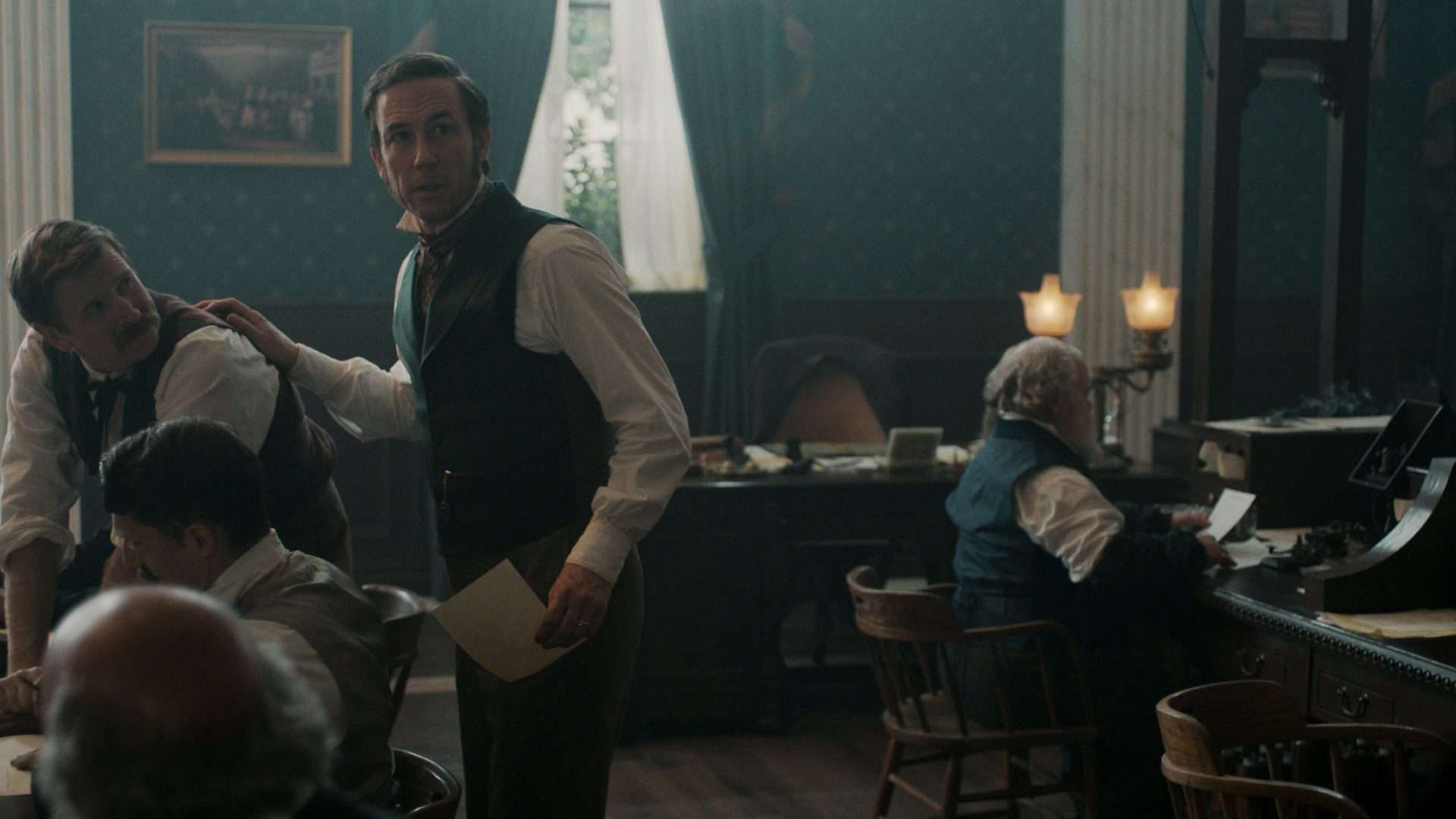
Manhunt Episode 2 “Post Morten” Recap:
Who is Lafayette Baker?
The episode opens with a dream sequence, showing Stanton as having been present during the assassination, managing to stop Booth from shooting and killing Lincoln. But as he overpowers Booth, Booth laughs at him and calls out his failure. That wakes Stanton up and forces him to be brought up to speed, mainly because they still don’t know where Booth is. We are introduced to Lafayette Baker, a detective employed by Edwin Stanton, to choose the primary detectives in the John Wilkes Booth case. An immediate apprehending of President Lincoln’s killers is necessary, per Stanton’s orders, as Baker tells a group of men.
Who is the new President being sworn in?
Stanton wakes a drunkenly passed-out Vice President Johnson so that he can get ready to execute his duties after being sworn in as the 17th President. Stanton doesn’t like him, a feeling that even Johnson is aware of, and Stanton also admits as much to his suspicions regarding how Johnson had survived, but Johnson rebuts by saying that he had been drunk and asleep.
Following Johnson’s oath of office, Baker tells Stanton that he and many others believe Johnson killed Lincoln because he stood to gain the most. Johnson is not exactly the most well-liked character, even from the show’s perspective. The fact that he emphatically states that the economy of the newly formed “United States” would be his priority, not “Negro rights,” automatically makes him less appealing, especially considering a holistic approach might have intermingled both of these issues. Stanton slyly admits that he “looks the part” while vocally disagreeing with Johnson regarding letting Booth fade away into obscurity rather than being caught. He finally toasts Johnson’s presidency before whispering in his ear that if he tries to obstruct Booth’s case, Stanton would spread the rumor that Johnson had been involved in the conspiracy.
What are the new leads Straton obtains?
A surprise lead is obtained by Stanton from Union officer Louis Weichmann. From the suspicious movements and mannerisms of the owner of Suratt Boardinghouse, Weichmann believes she might have more knowledge about the plot, especially considering Weichmann had hung around the Suratt boardinghouse the day of the murder. To corroborate Weichmann’s story, Stanton’s second Eckert goes with Weichmann to interview the widow, Surratt. Her story initially hadn’t been holding water, and it further breaks apart when Lewis Powell, the man suspected of having attacked Secretary Seward and covered in Seward’s blood, walks in. Powell and Surratt try to play off each other’s story, implicating both of them in the process. It leads to a brief struggle, but ultimately, they arrest the two of them.
However, when Suratt and Powell, under interrogation, failed to provide any information, the team decided to investigate Suratt’s tavern at Surattville, located 20 miles outside Washington, DC. Initially unable to locate evidence, Stanton finally locates a hidden room behind a wall. The room contained coded letters to Surratt’s son, John Jr., from Jefferson Davis, the leader of the Confederacy. Stanton, unsure of whom to believe, charges Weichmann with taking part in the plot to overthrow the government. Weichmann maintains that, before the conflict, he was merely friends with John Jr. Then, he continues, he saw Mary give John Jr., Booth, and Herold packages, which he now realizes might have contained weapons. Eckert, meanwhile, back at the office, tries to break the code but is unable to decipher it.
Meanwhile, Stanton also learns that John Jr. had applied for a courier post for him. Later that night, guards on the roof spot someone at Stanton’s house but are unable to catch him. The intruder leaves behind a footprint while escaping into the courtyard. Stanton asks for John Jr.’s shoe size, which had been in the courier application, before checking it with the footprint and discerning it to be a match. Someone is targeting Stanton as well.
What is Booth’s plan?
The plan by Stanton to warn Maryland and the surrounding countryside to stop the sale of horse feed works wonders, as that effectively strands Booth and Herold in Mudd’s company. The question does stem as to why Herold still sticks around, and “Manhunt” the show just answers with the excuse of being starstruck at Booth’s persona and getting a chance to work with him once John Jr. comes with the proposal.
Meanwhile, Mary Simms is subject to looking after Booth, leaving her bed for him, shaving him, and having to fend off insults. It leads to a flashback where we learn that she had managed to escape slavery but, ironically, had fallen back inside that same cage. It seems that Mudd still treats her and her brother as favors rather than equals, and that might have repercussions. While Booth, on a makeshift crutch, and Herold get ready to depart, Mudd, in a gesture quite unkind, rips open a page from Mary’s copy of the Underground Railroad, containing a map, and highlights a secret path through a settlement that would provide them cover until Richmond.
Meanwhile, Peanuts also informs Stanton that Booth has broken his leg and is limping. Realizing that Booth couldn’t have gone very far and would have to visit a doctor, Stanton narrows down his search radius. As a result, local officers call upon Mudd to interrogate him, whereby he dismisses having seen Booth but admits that the man whose foot he had treated didn’t have a mustache, so it’s difficult to discern.
Even Mary is questioned, and she is too scared to testify against Mudd but is shocked to learn that the man who had stayed back last night had been responsible for the president’s murder. John Surratt Jr. shows up at Mudd’s residence later that evening. Mudd claims he was unaware that the strategy had altered in light of Lincoln’s passing. While making John Jr.’s bed, Mary discovers a boot that Booth left behind, marked JWB.
Which location is chosen as Lincoln’s burial ground?
The episode also deals with the question of where to bury Lincoln. Stanton, perhaps out of affection and more logically because Lincoln had been the commander-in-chief, suggests Arlington, but Mary Todd refuses because Abe wouldn’t have wanted that on account of not being a soldier. While hard at the search for Booth, Stanton Jr. comes up with the idea to transport Lincoln’s body via a train, conducting multiple viewings throughout the country, finally ending at his hometown of Springfield. Stanton is supportive of the plan, not only because it would help Americans mourn Lincoln’s passing but also keep Booth out of the news.
At the station, Mary says goodbye to Mary and Robert, wishes his son safe travels, and has a poignant conversation with Mary’s friend Elizabeth Keckley, a black woman, who reminds Stanton that they have fought too hard for the country to go backward again. Mary’s final words to Stanton are to “Find the man who killed my husband.”.
As for Booth, the man who killed Mary’s husband, he and Herold arrive at the home of Ordell Swann, a freeman, who warns them from trespassing into his land by firing a gun in the air. He agrees to transport them through the settlement and, consequently, the secret path while the townspeople are inside the church, but only if they submit their weapons to him, which Booth and Herold have to relinquish reluctantly.
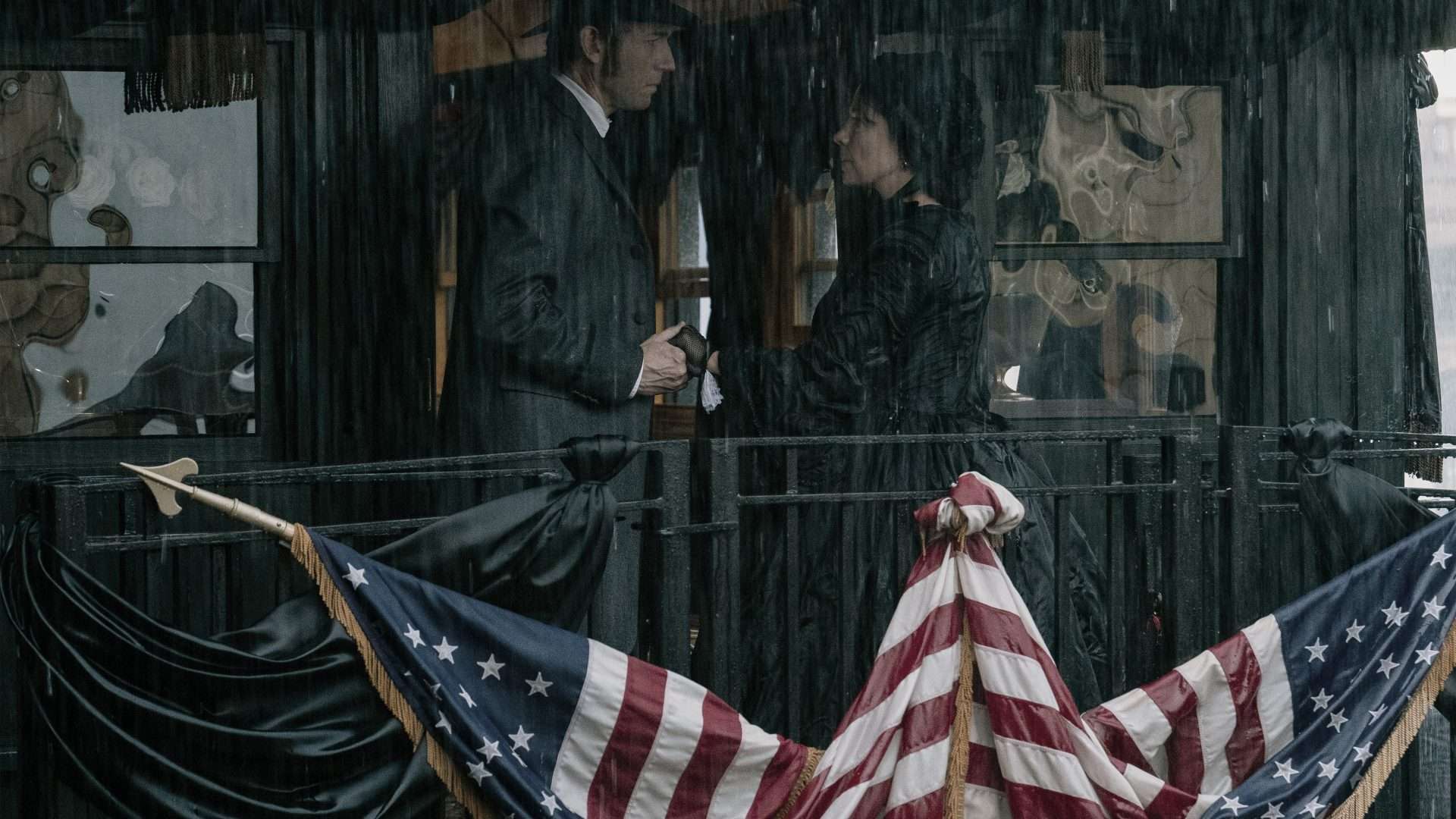
Manhunt Episode 3 “Let the Sheep Flee” Recap:
What does John Wilkes Booth dream?
If every episode opens with a dream sequence of each of the characters, that would be one of the few times this series shows some semblance of uniqueness. For Booth, his dream seems to be one of adulation for a job well done. And as for the job, he feels he deserves to be the President of the Confederate States of America. There is a strange delusion driving him forward, where he even believes that his journal will be a bestseller once the Confederates rise again. He is also delusional enough to believe they don’t need Swann, even though Swann is the only reason they could even reach Rich Hill.
What are the difficulties facing Stanton in implementing the Reconstruction Plan?
This episode focuses on Lincoln’s perspective regarding putting the focus on the little guy. Johnson, on the other hand, had previously hinted at focusing more on the economy than the rights of blacks. Now, Reconstruction plans to ensure the incorporation of freed slaves into society while also ensuring the punishment of the Confederate leadership. When Johnson asks what the plan is about the rebels, the flashback shows Lincoln having a plan to remunerate the old slave owners with some tax-saving schemes for the simple reason that they don’t need to flaunt power, as they are in power.
Stanton very correctly assumes he is worried about the leadership rather than the working-class confederates because they are planning to escape from Richmond (the capital of the Confederacy) and the New York Branch to Montreal, and as it stands, that turns out to be the plan. As Lincoln states, it’s okay to let the sheep flee, but what if the wolves also flee in the garb of the sheep? Back at the present, Johnson emphatically states that these planters and the secessionists had tried to start their own country, held onto their slavery, and had royally failed. But this delay in Booth’s capture is making Johnson look bad, so it’s better to either capture them or, if unable to, just let them go.
Later in the episode, the free distribution of food and rations to the townspeople (especially from the perspective of the African Americans) by the War Department (also led by African Americans) becomes a full-scale riot when a white woman starts complaining about having the right to take the same amount of loaves of bread, which escalates. In that process, one African American kid tries to take his horse away (which he had managed to buy from his master after saving money for over six years), and that leads to a racist officer and a racist nobleman trying to argue that the man is stealing the horse, which leads to a shootout, leading to the death of the unfortunate young black man.
The unfortunate tragedy is witnessed by Stanton, who had also tried and failed to avert this tragedy to no avail. It isn’t helped by his asthma exacerbating every day, with the doctor warning that a further attack of this intensity would prove fatal. It leads to a strain in his marriage, with his already-suffering wife complaining legitimately about his proclivity to micromanage, fighting a war from behind the desk, and not being able to heed his doctor’s orders. What is also driving Stanton is a conversation he had with Lincoln and Senator Douglas two and a half years before his assassination, where they both agreed and tried to bring in amendments to laws that would allow colored voters to fight for the Union in the war by hiring them as volunteers, paying them for their labor in uniform, and hiring them from a tactical rather than moral standpoint.
The righteous anger faced by Stanton over the tragic death of the young private leads to him calling for a lawyer and asking him about precedents for convicting the shooter, Frank Leech. There are precedents, but Stanton asking the lawyer to disobey attempts to free Leech wouldn’t fly, even if Lincoln wanted that to be the norm for racially motivated attacks, not only because Lincoln isn’t there right now, but Johnson is now more inclined to grant the rebels, like Leech, full pardons.
All the generals, congressmen, and men indicted for treason aren’t covered in this amnesty plan, but Johnson is strongly encouraging it. When confronting Johnson with having 100 pardon plans for the Confederates, Johnson does point out that the tragedy could easily be recontextualized as Leech acting in self-defense. But Johnson has no response for effectively working contrary to what both Stanton and he had agreed on previously.
Where is Surratt?
We are introduced to Senator Sanders, who has deep pockets and has been involved in the Confederate cause. Now Conover, under the non-de-guerre John Wallace, a bounty hunter and middleman, tries to ask questions regarding John Surratt’s location. Sanders informs him that Surratt has gone to see his father, whom all concerned already know is dead. The message is passed to the War Department, whereby they decipher it by asking the imprisoned Powell and learning that both Weichmann and Suratt had been in the seminary before Suratt joined the confederacy. That is the “father” the code is referencing. This leads to Stanton ordering Conover, through Eckert, to move in haste to the Catholic Monastery in Montreal.
Conover goes to the church and holds Surratt at gunpoint, urging him to believe that Sanders had sent him to be dispatched safely to the train as if Surratt got captured by Stanton, he wouldn’t earn a pardon. But Conver makes a mistake since he has given Surratt a ticket to a ship. Realizing that his game is up, Conover asks Surratt where Booth is, to which Surratt chooses not to answer and instead attacks Conover.
What is Booth’s ultimate plan?
Meanwhile, at Rich Hill, Swann leads Booth and Herold to Rich Hill, where they face off in a Mexican standoff where Swann asks for five dollars, and they refuse to pay him. It’s fascinating how Booth’s prowess as an actor is what is bringing him notoriety rather than what he would be known for down the line. Held at gunpoint, Herold knocks on the door of Mudd’s contact, who we learn is a man named Cox. Cox, realizing who Booth is, urges Swann to put his guns down and invite Booth to his house’s basement, which reveals the hideout of the CSS (Confederate Secret Service), a line of agents loyal to the Confederacy connected to Richmond.
Cox, amidst the Confederacy’s support in Europe and other countries, profited from their agriculture as well as their slave trade. And now that Booth has taken care of Lincoln, Cox strongly believes that the “Southern” way of life can be revived. But for Booth to remain alive, he needs to escape the continent to Mexico, while Booth, to sustain his adulation and validation, wants to go to Richmond to meet with “President” Davis. Never mind that Richmond is now a ruined city, with any supporters left already scattered and Davis already on the run, but Cox agrees to run them on the south, and Herold is already instructed to prepare the horses.
The primary question the show wants the viewer to ask is why Herold is still sticking around with Booth, even after being treated with equal billing as an African American. The same question is asked directly by Swann to Herold, to which Herold has no answer. He instead tries to rebut the accusation that he is a lackey to Booth by reminding Swann that he is effectively betraying his race by helping people ferry across the secret line, which Swann disagrees with, choosing to look at it as a job, a profit-making venture from the knowledge he has on the terrain.
Meanwhile, Cox lays out the plan: Swann would take Booth and Herold to a pine thicket about a mile from Rich Hill, which is protected by the line. There, they would have to wait for an agent named “The River Ghost,” who would take them to Virginia. Swann, meanwhile, reneges on the deal for an extra three dollars, which Booth refuses to give. Swann threatens to tell the River Ghost to leave them in the pine thicket until they starve and are chewed on by wolves.
Herold, like the dutiful lackey he is, picks up the coins dropped by Booth and gives them to Swann, with the promise of giving them three dollars extra once they reach their destination. Swann acquiesces, only to extract three extra dollars for giving their guns back. At this point, you would have to respect Swann, even if what he is doing is effectively aiding and abetting the transport of a fugitive, but he is earning good money from it. He is also forcing Herold to ask the hard question to Booth, to which Booth gives the stock answer that Herold is the only one he can trust, and he knows that Herold’s worshipful fandom could be utilized to Booth’s advantage.
Does Stanton manage to capture Surratt?
We see Stanton getting ready to travel to Montreal via train, much to the displeasure of his wife, who chooses to go home to her mother’s in Nantucket. While on the train, Stanton remembers the last meeting he and Senator Douglas had with President Lincoln, where Lincoln had urged the two of them to work together to ensure the Underground Railroad remains active in transporting slaves from the South to the North, even if Lincoln wouldn’t be elected for a second term. It dawns on you that Stanton is chasing after the ghostly ideals of Lincoln, even as hard realities like Senator Douglas, with their deep pockets in the media and a bone to pick with Stanton, are present at every step.
Stanton manages to free Conover, who had been knocked out and tied up in Surratt’s room. Upon learning that Surratt had escaped on a ship, Stanton goes to the nearest Navy outpost, where they learn that Surratt had intentionally managed to sabotage a ship and orchestrate an accident. While the navy was trying to save the people from drowning, Surratt had managed to swim to another vessel close by, a Confederate vessel on the way to Liverpool. Much to Stanton’s consternation, the vessel had managed to slip past a gap in the navy blockade because they were informed of the patrol timings.
Stanton was understandably angry that they couldn’t capture Surratt because he was the only solid lead they had. But the navy did recover John Wilkes Booth’s trunk from the sunken ship, which also had Booth’s name on the manifest but not Surratt’s. This made Stanton realize that the plan to sink the ship was part of an elaborate ruse such that people would believe that Booth had passed away. More interestingly, the ship that Surratt had escaped to had been chartered by one John Sanders.
Manhunt Episode 3 “Let the Sheep Flee” Ending, Explained:
What does Eckert decipher from the telegram?
Meanwhile, Eckert had been assigned to look after the funeral proceedings for the unfortunate private. During that funeral, Eckert learns from the volunteers that they had been enslaved by the Richmond Confederate leaders, and thus, they have an idea of how the Confederacy could manage to send coded telegrams. More specifically, they can identify the decoding machine. This leads to a badly lit CGI sequence of the Union soldiers, along with Eckert storming the offices of the Confederacy within a ruined Richmond and locating the decoder in a hidden cabinet in the main office desk of presumably Jefferson Davis. The key is a phrase titled “Complete Victory,” through which Eckert decodes that the telegram reads “Complete Retribution.”.
While Booth and Herold waited in the pine thicket, freezing in the dead of night, they were met by a stealthy River Ghost, who had brought food for them but refused to guide them to Virginia right away as the Union boats were patrolling up and down the river. Instead, he orders them to stay put, reminding them that they will get to Virginia in due time. The episode does end with Booth shooting his horse, as it had been disturbing them from their slumber, and ordering Herold to do the same, but Herold fails at it. At this juncture, Booth is slowly resembling a wild card, and Herold would need to get off this gravy train if he wants to survive.
Meanwhile, Stanton meets with Baker, where he reveals the contents of the telegram and what he perceives to be the assassination order. While he can’t prove it, he can prove that Sanders is the one who bankrolled this entire operation and might have been the sole patron of Booth’s play. Baker agrees and asks whether they should bring him in, but Stanton reveals that Sanders had just bought the Weekly and is controlling the narrative, painting Stanton as a vengeful lawman unreasonably targeting Booth. Baker advises him to tell a better story in response.
As the episode ends, we see Sanders in a splendorous office space, surrounded presumably by the Confederacy leadership, where he reads out the telegram. Johnson isn’t open to granting amnesty to the Confederate leadership, but most of its supporters are eligible for pardons. With Lincoln out of the way, they had a chance to resume the slave trade, while Sanders also pointed out that the rebels, the supporters of secession, wouldn’t be granted pardons.
Thus, it would be wise for them to sail to Europe, where they would be welcomed with open arms, while Sanders would ensure they would remain free. But amidst these dire straits, we also see the Simms siblings finally getting a taste of identity and freedom once they get the mail allotting them to their free land — the true mark of freedom that the secessionists couldn’t take away from them, however much they tried.




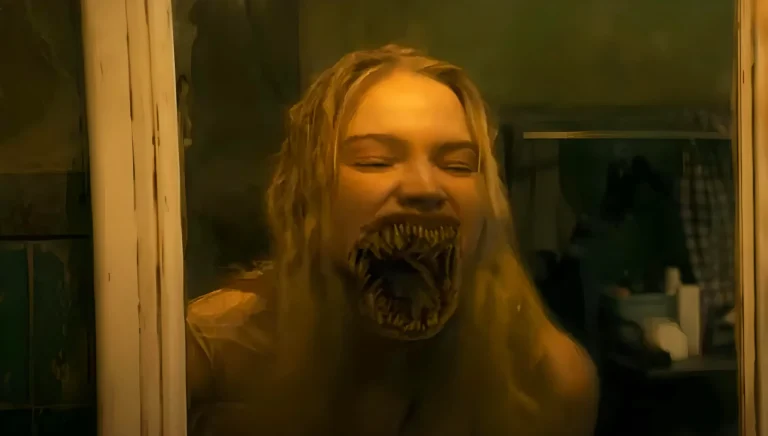
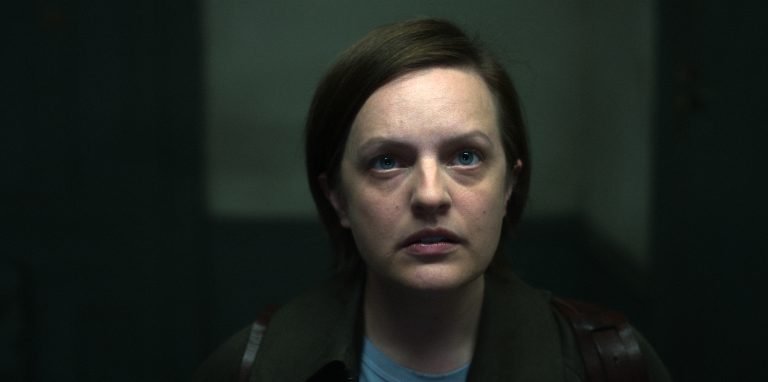
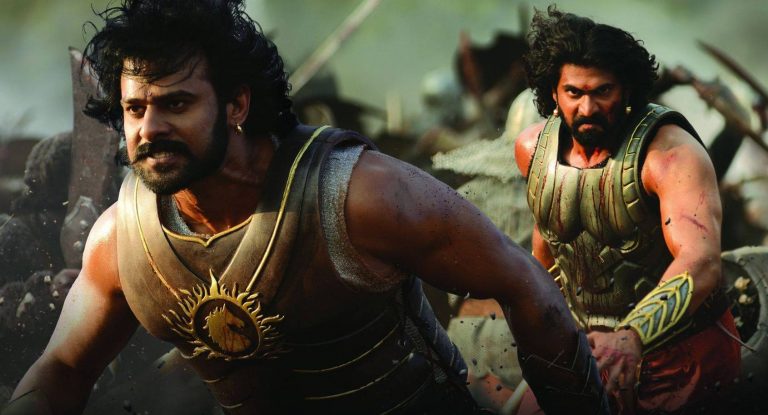
![The Disaster Artist [2017]: Filling the Hollow](https://79468c92.delivery.rocketcdn.me/wp-content/uploads/2019/02/the-disaster-artist-768x432.jpg)

